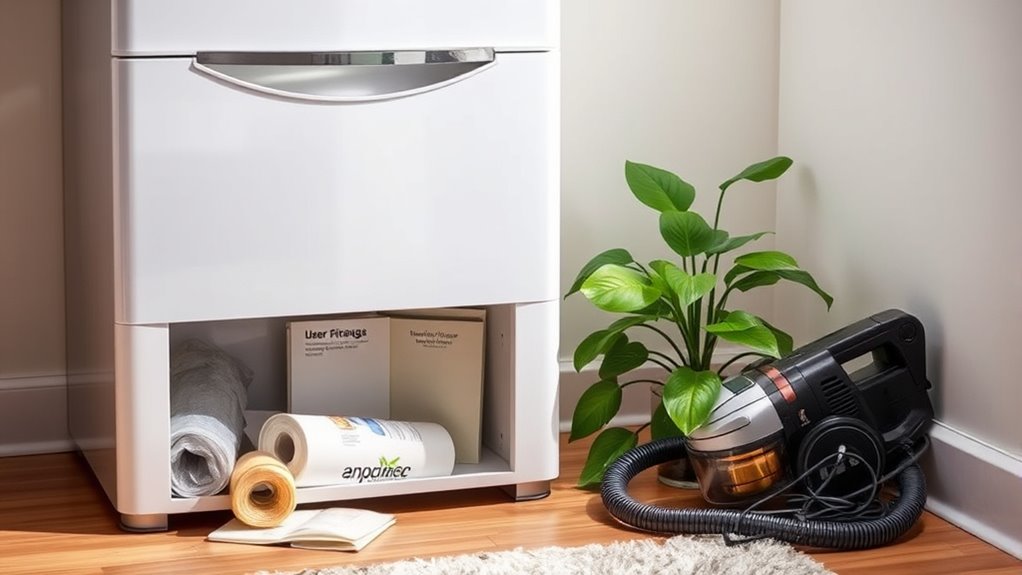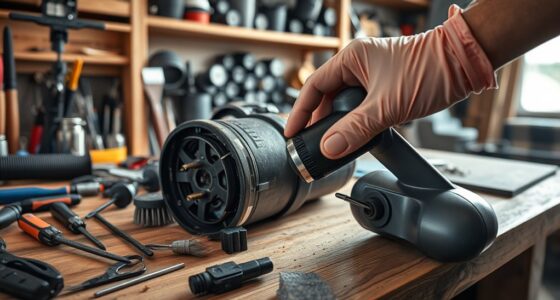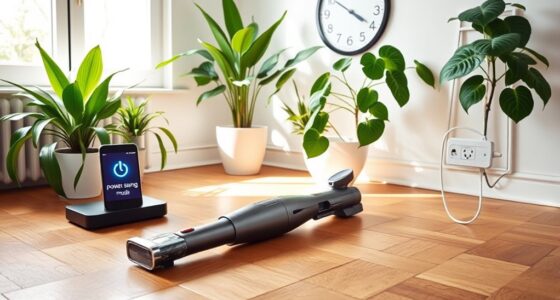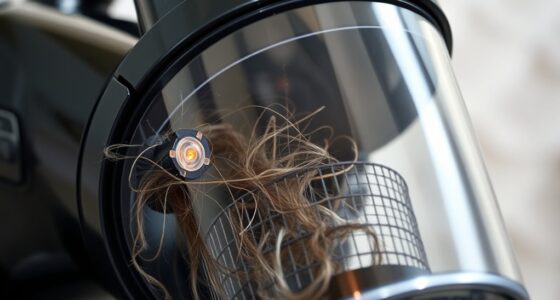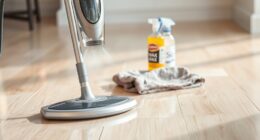To keep your vacuum in top shape, store it in a clutter-free, dry space away from extreme temperatures. Clean it before storage by emptying the dustbin and washing filters. Carefully wrap the cord, avoiding tight pulls to prevent damage. Elevate your vacuum and use a dust cover for protection. For cordless models, maintain the battery at 50% charge during long-term storage. Follow these tips, and you’ll be ready to discover more essential practices to enhance your vacuum’s longevity.
Key Takeaways
- Always clean your vacuum before storage by emptying the dustbin and washing filters to prevent odors and maintain hygiene.
- Store the vacuum in a clutter-free, dry area away from extreme temperatures to preserve its performance and prevent damage.
- Properly wrap the cord in a figure-eight pattern around designated hooks to avoid tangling and internal damage.
- Use a dust cover to protect the vacuum from dust and ensure it’s elevated to maintain cleanliness and prevent moisture damage.
- For cordless models, keep the battery charged at 50% during long-term storage and avoid overcharging to extend its lifespan.
Choosing the Right Storage Location
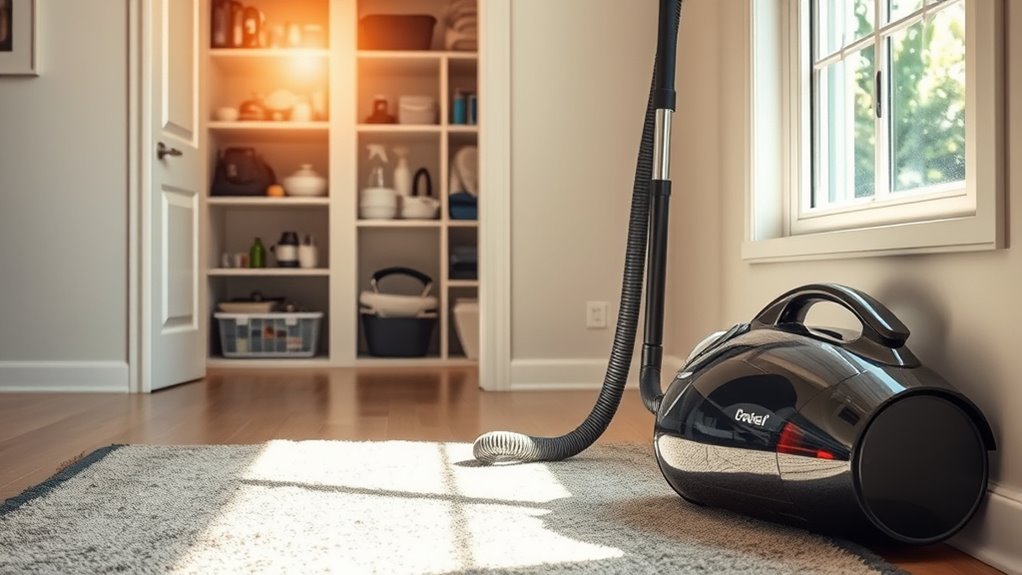
When it comes to storing your vacuum cleaner, the right location can make all the difference. Choose a clutter-free area that’s easily accessible to guarantee proper storage and reduce the risk of damage from foot traffic.
Avoid extreme temperature spots like garages or attics, as fluctuating temperatures can hurt your vacuum’s performance. If space is tight, consider using storage racks or wall mounts to make the most of your vertical storage space. Additionally, lightweight designs are easier to handle when stored correctly, allowing for seamless access when needed.
Keep the storage area clean and well-ventilated to minimize dust accumulation and prevent moisture buildup that could lead to mold. Elevate your vacuum by placing it on a shelf or in a cabinet, and cover it with a dust cover for extra protection. Additionally, ensure that the area is free from high suction power which could inadvertently affect the vacuum’s motor if stored improperly.
Cleaning Your Vacuum Before Storage
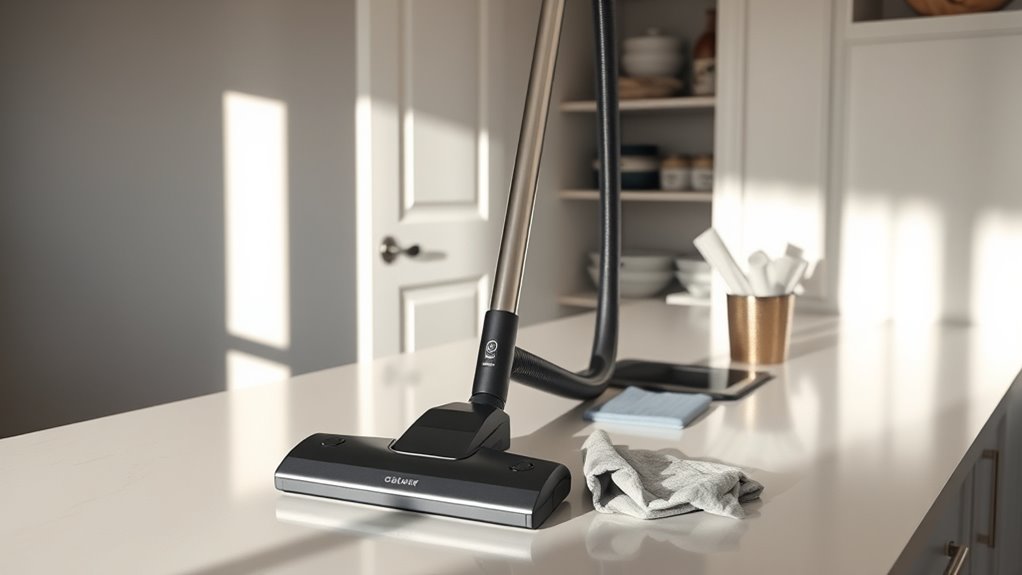
After you’ve found the perfect spot for your vacuum cleaner, it’s time to focus on cleaning it before storage. Start by emptying the dustbin or replacing the vacuum bag to prevent odors and maintain cleanliness.
Next, clean the washable filters by rinsing them thoroughly and allowing them to air dry completely. Regular maintenance of filters is crucial for optimal suction power and performance, as consistent maintenance can prevent costly repairs. Regularly checking and cleaning your filters can help enhance the vacuum’s efficiency. Don’t forget to check the brush roll for tangled hair and debris—use scissors to remove any clogs.
Once that’s done, wipe down the exterior with a damp cloth to keep it looking good and free from dust accumulation.
Finally, conduct a once-over check of the vacuum’s components to verify all parts are properly reassembled and functional. This way, your vacuum will be ready for its next use! Regular maintenance, such as cleaning your HEPA filters, can significantly enhance the vacuum’s performance and lifespan.
Properly Wrapping the Cord
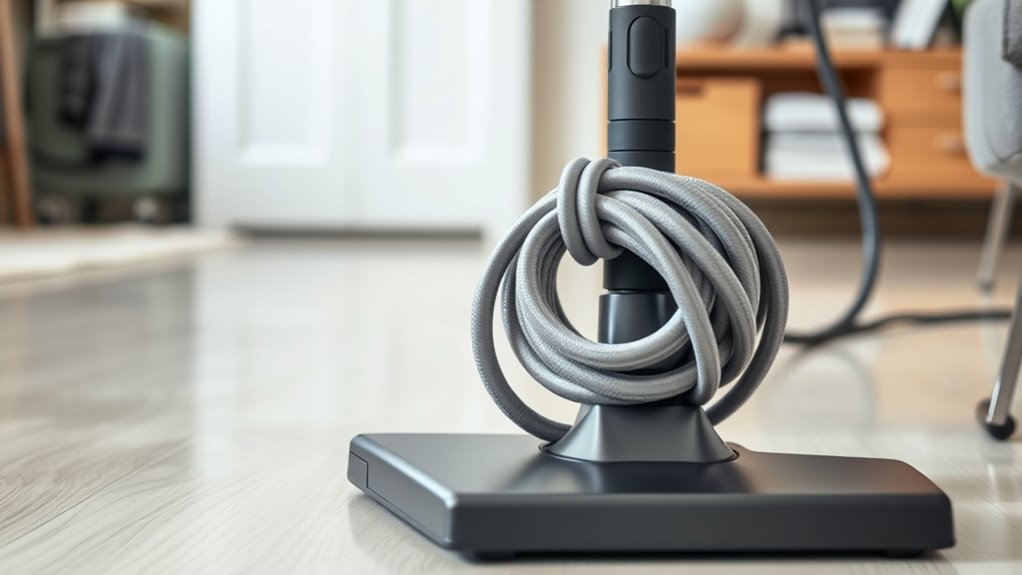
To guarantee your vacuum is stored safely and efficiently, start by unplugging it to prevent any electrical hazards.
Unplug your vacuum to ensure safe storage and avoid any electrical hazards.
Next, you’ll want to focus on properly wrapping the cord. Here are three steps to make certain it’s done right:
- Straighten the cord fully before wrapping to reduce stress and prevent tangles.
- Wrap the cord around the vacuum’s designated hooks in a neat, figure-eight pattern. Avoid pulling it too tightly to prevent internal damage.
- Store extension cords separately to keep everything accessible and organized, using storage containers or hooks for larger attachments.
Protecting the Vacuum From Dust and Moisture
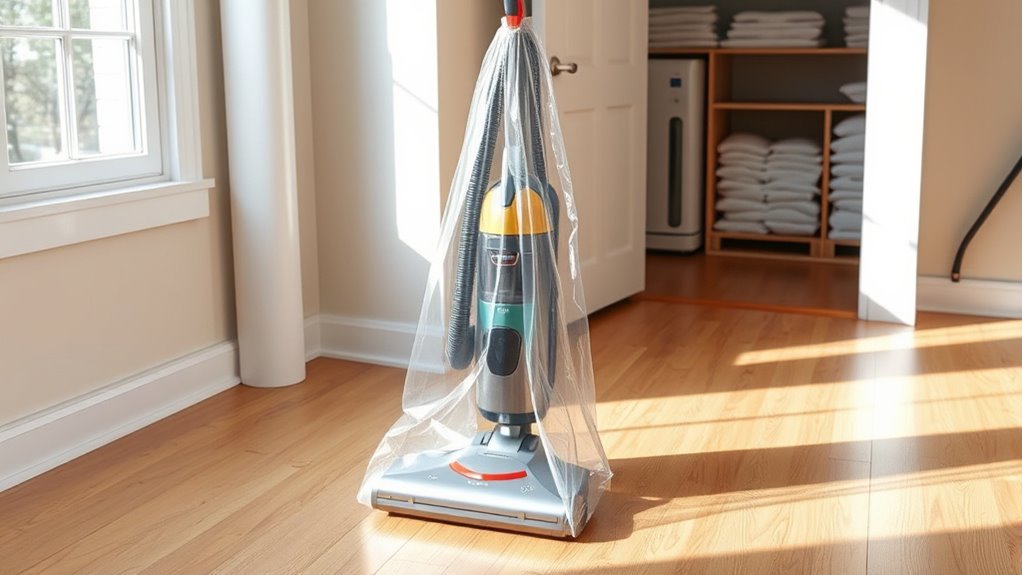
Once you’ve properly wrapped the cord and guaranteed safe storage, protecting your vacuum from dust and moisture becomes essential. To keep your vacuum clean and in prime condition, elevate it by storing it on a shelf or in a cabinet. Use a dust cover to prevent dust accumulation and make certain the area is dry and well-ventilated. Avoid damp locations like basements or garages, and steer clear of water sources. If you live in a humid climate, consider using a dehumidifier to control moisture levels. Regularly check for dust buildup and clean as needed to maintain functionality. Additionally, ensuring your vacuum has advanced filtration systems can help maintain its performance over time.
| Action | Purpose |
|---|---|
| Store on a shelf | Prevents dust buildup |
| Use a dust cover | Keeps vacuum clean |
| Maintain a dry area | Prevents moisture damage |
| Clean regularly | Guarantees peak performance |
Maintaining the Battery for Cordless Models
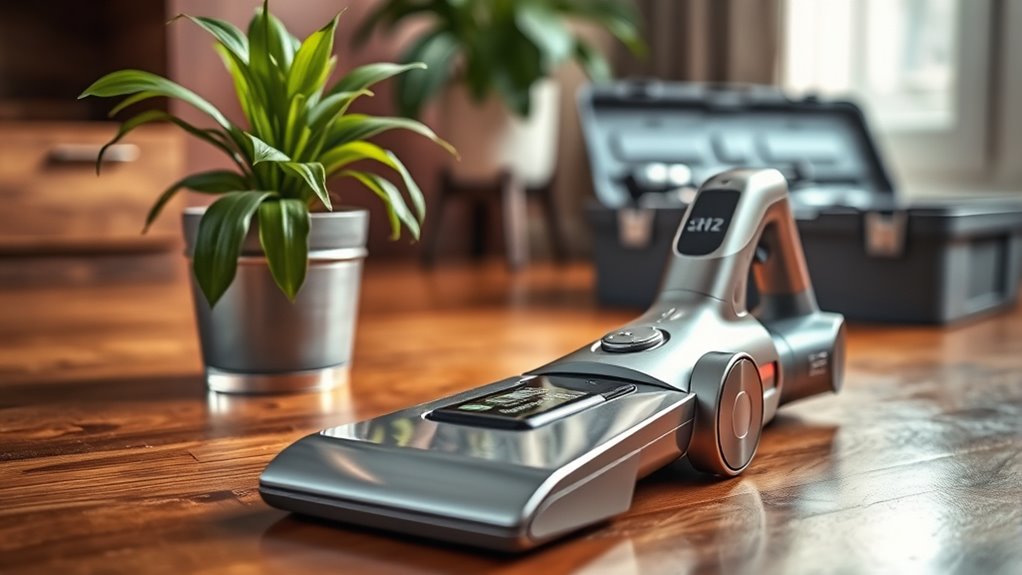
Cordless vacuum models rely heavily on battery maintenance to guarantee longevity and peak performance.
To keep your battery in top shape, follow these guidelines:
- Charge when low: Charge the battery when it reaches 20-30% to extend its lifespan and prevent deep discharge.
- Ideal storage: For long-term storage, maintain the battery at about 50% charge to preserve health and performance.
- Clean contacts: Before you store your vacuum, gently clean the battery contacts with a dry cloth to ensure good connectivity and prevent corrosion.
Avoid overcharging, as this can reduce capacity and lifespan.
Additionally, store your vacuum in a cool, dry place to protect the battery and maintain its ideal functionality.
Seasonal Storage Tips
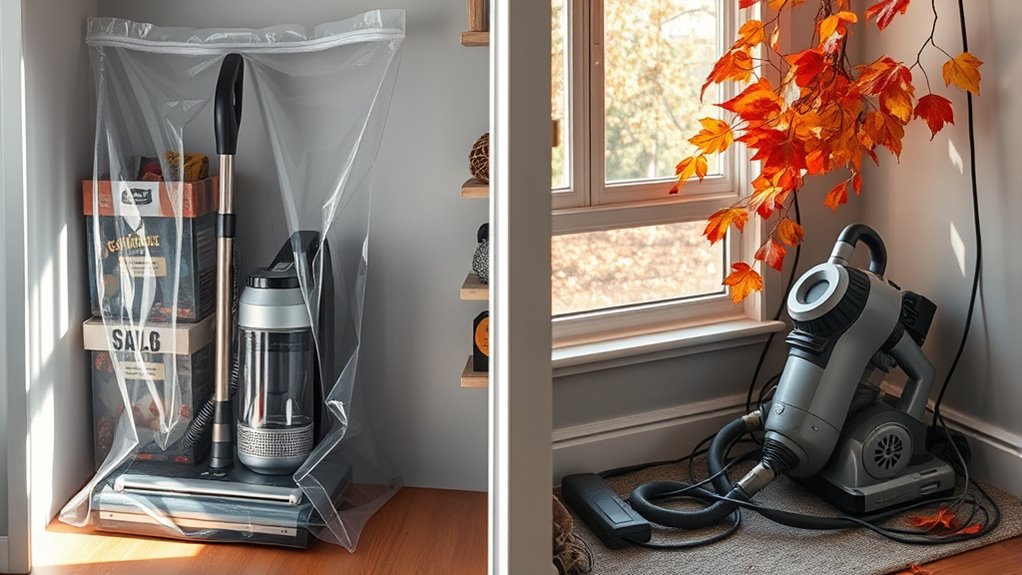
When it comes to seasonal storage, proper preparation is key to ensuring your items stay in great condition until you need them again.
Start by making sure your seasonal décor and clothing are clean and dry to prevent mold and odors during storage. Use vacuum seal bags to compress bulky bedding, maximizing storage space while keeping items protected from dust and moisture.
Don’t forget to label each storage bag with its contents and the appropriate season for easy retrieval. For items like potpourri, vacuum sealing helps maintain freshness and prevents damage over time. Additionally, regular grooming reduces shedding significantly, which can help keep pet hair at bay in stored items.
Finally, periodically check your stored items for any leaks or damage in the vacuum seals, ensuring everything remains in prime condition until you’re ready to use them again.
Troubleshooting Common Storage Issues
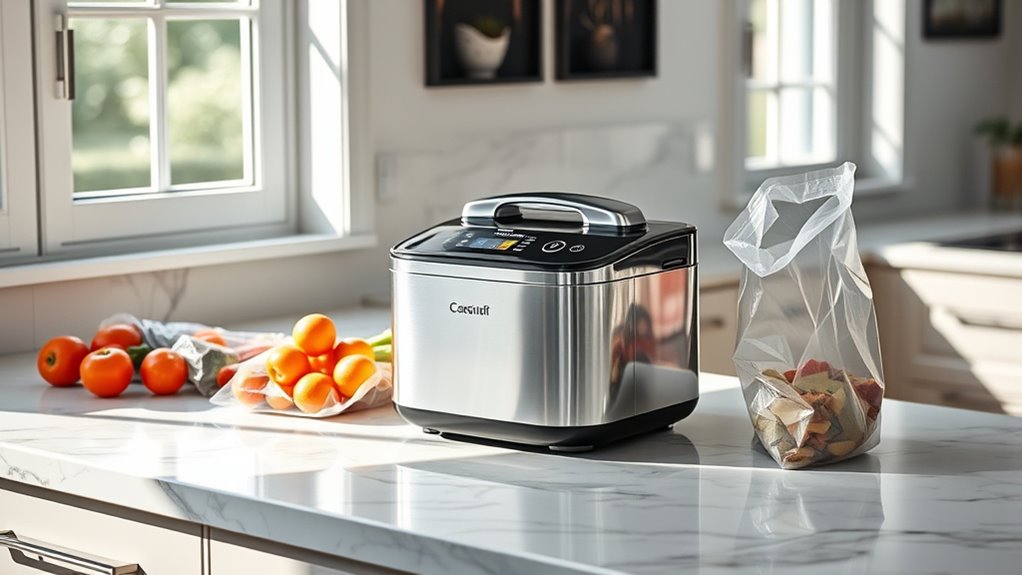
When it comes to storing your vacuum, you might face a few common issues that can affect its performance.
You’ll want to prevent dust accumulation and guarantee everything’s in good shape before storage.
Let’s tackle these problems head-on so your vacuum stays ready for action when you need it.
Common Storage Problems
While vacuum storage can greatly extend the life of your items, common issues can arise that compromise their effectiveness.
Here are three problems to watch for:
- Compromised Seals: Regularly inspect your vacuum sealed bags for leaks or damage. Moisture and air exposure can degrade stored items. Additionally, using HEPA filters in your storage area can help reduce the presence of allergens and pollutants, further protecting your items. Implementing preventive maintenance strategies can also enhance the overall effectiveness of your vacuum storage solutions. Be aware that using specialized vacuum cleaners can help maintain the quality of your items before storage.
- Overfilled Bags: Make sure you don’t overfill vacuum storage bags. Adhere to the maximum fill line to prevent breakage and make certain proper sealing.
- Storage Conditions: Maintain a clean storage area for your vacuum-sealed items. Dust and moisture can accumulate and damage contents.
To keep everything in top shape, store your vacuum cleaner and vacuum-sealed bags in a cool, dry place. Additionally, ensure that your storage environment has effective air filtration to further protect your items from pollutants and moisture.
Address these problems promptly to protect your stored items effectively.
Preventing Dust Accumulation
Dust accumulation can be a significant issue for your vacuum storage, but with a few simple strategies, you can keep it at bay.
First, store your vacuum in a designated area, like a closet or cabinet, away from dust-prone locations. Cover it with a dust cover or cloth when not in use to minimize the need for frequent cleaning.
Regularly check and clean the storage area to reduce dust buildup. Elevate your vacuum off the ground by placing it on a shelf or inside a cabinet, avoiding contact with floor dust and debris.
Finally, steer clear of damp environments, as moisture can lead to mold growth and further dust accumulation, compromising your vacuum’s functionality.
Frequently Asked Questions
What Shouldn’t You Vacuum Pack?
You shouldn’t vacuum pack delicate items like natural fibers and fluffy clothing, as they can lose their shape.
Avoid sealing sharp-edged items, which can puncture bags and ruin the seal.
Don’t pack liquids or high-moisture foods without precautions, since they might leak.
Also, steer clear of vacuum packing freshly laundered items unless they’re completely dry to prevent mold.
Finally, delicate fruits and soft pastries shouldn’t be vacuum packed to avoid crushing.
Do Vacuum Storage Bags Wrinkle Your Clothes?
Oh sure, vacuum storage bags are just magical wrinkle machines! You’ll stuff your favorite clothes in, and voilà—instant crumple!
But seriously, yes, they can wrinkle your clothes, especially those delicate fabrics. If you want to keep them looking sharp, fold your clothes neatly and don’t overstuff the bags.
Try adding tissue paper between layers and hang them up or lay them flat right after you take them out to help smooth things out.
Should Vacuum Sealer Bags Be Smooth Side up or Down?
When using vacuum sealer bags, you should place the smooth side down toward the heating element. This orientation guarantees a proper seal.
The textured side faces up, allowing the vacuum to effectively extract air. If you don’t follow this guideline, you risk improper sealing, which can lead to air leaks and spoilage.
Always check your vacuum sealer’s user manual for specific instructions, as some models may have different requirements.
How to Organize a Vacuum Cleaner?
Imagine your vacuum cleaner as a loyal steed, ready to gallop into action at a moment’s notice.
To organize it effectively, choose a clutter-free corner, away from humidity and extreme temperatures.
After each use, empty the dustbin, clean its filters, and wrap the power cord neatly.
Elevate it on a shelf, cover it with a dust cover, and keep attachments in a designated bin.
Regularly check for wear, ensuring it’s always battle-ready.
Conclusion
By following these do’s and don’ts, you can keep your vacuum in top shape and extend its lifespan. Did you know that properly maintaining your vacuum can increase its longevity by up to 50%? This means less frequent replacements and more efficient cleaning. So, whether you’re storing for the season or just tidying up, take the time to protect your appliance. A little effort now can save you money and hassle down the road!
